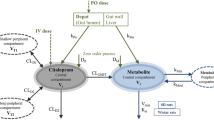Summary
The kinetic profiles of phenazepam and its hydroxylated derivative were compared in rat, dog, cat and man after administration of single oral doses of the parent compound. The absorption of phenazepam was reasonably rapid in all the species studied. Blood peak concentrations (Cmax) were reached at 1 h in rats (0.32 ± 0.03 μg/ml), at 0.5 h in dogs 0.54 ± 0.10 μg/ml), at about 2 h in cats (1.65 ±0.23 μg/ml), abut only at 4 h in man (0.038 μg/ml) at the highest dose tested. The largest normalized (value/dose) Cmax and area under the curve (AUC) were observed in man, while the rat gave the lowest values. The half-life of phenazepam was about 60 h in man, 13.72 ± 2.09 h in the cat, 6.35 ± 2.32 h in the dog and 7.49 ± 1.88 h in the rat (β-half-life). 3-OH-phenazepam was rapidly detected in cat, rat, and dog blood but no measurable amounts (< 3 ng/ml) were found in human blood. At the oral doses tested, the ratio of the AUC for 3-OH-phenazepam to phenazepam was 0.01, 0.48, and 0.53 in the dog, rat, and cat, respectively. The half-life of the metabolite was shorter than that of the parent compound in the dog, but it was comparable in the rat and longer in the cat. The results suggest that 3-OH- phenazepam might contribute to the overall pharmacological effects of the parent compound in those species in which it accumulates in significant amounts.
Similar content being viewed by others
References
Bogatskii, A.V., Andronati, S.A., Vikhlyaev, Yu.L, Klygul, T.A., Rudenko, O.P., Zakusov, V.V. and Yakubovskaya, L.N. (1975): Inventor’s Certificate of the USSR No. 484,873 (C1.A61K) of Sept. 25, 1975, Appl. No. 1,992,344 of Jan. 1974. In: Otkrytiya, Izobret, Prom. Obraztsy, Tovarnye Znaky, 1975, 52 (35), 12.
Vikhlyaev, Yu.I. and Voronina, T.A. (1978): Novyie lekarstvennyie preparatyEkspress-informatsiya VNIIMI, No. 3. p. 2.
Lanzoni, J., Airoldi, L., Marcucci, F. and Mussini, E. (1979): J. Chromatogr., Gas chromatographic determination of chlorodesmethyldiazepam and lorazepam in rats and mice.,168, 260–265.
Garattini, S., Marcucci, F. and Mussini, E. (1977): The metabolism of pharmacokinetics of selected benzodiazepines. In: Psychotherapeutic Drugs, pt. II, Applications. Ed. E. Usdin and I.S. Forrest, published by M. Dekker, New York, pp. 1039–1087.
Ekonomov, A.L., Rodionov, A.P., Zherdev; V.P. and Vikhlyaev, Yu.I. (1979): Xenobiotica 7-Bromo-5-(2′-chloropheny 1)-1,3-dihydro-2H-1,4-benzodiazepin-2-one (I), a new tranquillizing agent: Metabolism in rats.,9, 503–510.
Marcucci, F., Mussini, E., Airoldi, L., Guaitani, A. and Garattini, S. (1972): J. Pharm. Pharmac, Brain concentrations of lorazepam and oxazepam at equal degree of anticonvulsant activity.,24, 63–64.
Randall, L.O. and Kappell, B. (1973): Pharmacological activity of some benzodiazepines and their metabolites. In: The Benzodiazepines, Ed. S. Garattini, E. Mussini and L.O. Randall, published by Raven Press, New York, pp. 27–51.
Schwartz, M.A. (1973): Pathways of metabolism of the benzodiazepines. In: The Benzodiazepines, Ed. S. Garattini, E. Mussini and L.O. Randall, published by Raven Press, New York, pp. 53–74.
Caccia, S., Ballabio, M. and Garattini, S. (1981): J. Pharm. Pharmac, Relationship between camazepam, N-methyl-oxazepam and oxazepam. Brain concentrations and antileptazol effect in the rat. in press.
Marcucci, F., Guaitani, A., Kvetina, J., Mussini, E. and Garattini, S. (1968): Eur. J. Pharmac. Species difference in diazepam metabolism and anticonvulsant effect.,4, 467–170.
Marcucci, F., Fanelli, R., Mussini, E. and Garattini, S. (1970): Eur. J. Pharmac, Further studies on species difference in diazepam. Metabolism.,9: 253–256.
Garattini, S., Mussini, E., Marcucci, F. and Guaitani, A. (1973): Metabolic studies on benzodiazepines in various animal species. In: The Benzodiazepines, Ed. S. Garattini, E. Mussini and L.O. Randall, published by Raven Press, New York, pp. 75–97.
Caccia, S., Guiso, G. and Garattini, S. (1980): J. Pharm. Pharmac. Brain concentrations of clobazam and N-desmethylclobazam and antileptazol activity.32, 295–296.
Caccia, S., Guiso, G., Samanin, R., and Garattini, S. (1980): J. Pharm. Pharmac. Species differences in clobazam metabolism and antileptazol effect.32, 101–103.
Garattini, S., Caccia, S., Carli, M. and Mennini, T. (1980): Notes on kinetics and metabolism of benzodiazepines. Presented at 12th.CINP Congress, Göteborg, June 22–26, 1980.
Author information
Authors and Affiliations
Rights and permissions
About this article
Cite this article
Zherdev, V.P., Caccia, S., Garattini, S. et al. Species differences in phenazeram kinetics and metabolism. European Journal of Drug Metabolism and Pharmacokinetics 7, 191–196 (1982). https://doi.org/10.1007/BF03189565
Received:
Issue Date:
DOI: https://doi.org/10.1007/BF03189565




